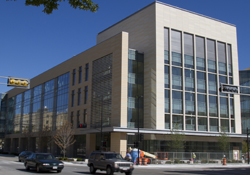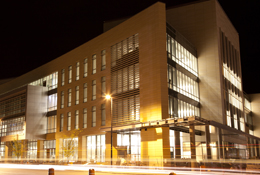
MADISON, Wis. — Officials from the newly-opened Wisconsin Institute for Discovery and Morgridge Institute for Research describe the new structure as very transparent.
“You can basically see through it — you can’t hide in it,” said Janet Kelley, communications director for the Wisconsin Alumni Research Foundation, the organization funding part of the new public-private twin buildings on the University of Wisconsin-Madison campus.
The transparency is intended on both a structural and operational level. The facility was designed to encourage interaction and collaboration among different disciplines — the goal of the three groups that brought the project together.
The idea for the twin institutes was first proposed by former Gov. Jim Doyle about six years ago and “taken up with great enthusiasm” by alumni John and Tasha Morgridge, who donated the initial $50 million to kick it off, Kelley said.
Construction on the five-story, 300,000 square-foot project began three years ago in an effort to ensure that the city of Madison and the university stay at the forefront of research worldwide, she said.
The building, which cost a total of $150 million to build and an additional $60 million for laboratory fit-outs, equipment and support, uses 50 percent less energy and water than a typical lab building on campus, according to the university.
This is the first research facility on the UW-Madison campus with a geothermal heating system and the first designed to achieve LEED Silver certification for green building practices, the school reports. Building features include solar panels on the roof and pumps that recover water to irrigate the plants.
 “This facility is unique, it does not belong to a particular department or discipline, it’s not a home to any department on campus,” Kelley said. “The scientists who were selected and who want to work there really want to — and see the importance of — working together.”
“This facility is unique, it does not belong to a particular department or discipline, it’s not a home to any department on campus,” Kelley said. “The scientists who were selected and who want to work there really want to — and see the importance of — working together.”
Employees are still in the process of moving in, but the building will have space for 400 employees, she said.
The Institutes are designed primarily for research rather than for traditional classes, but will include embedded teaching labs designed exactly like the research labs for instruction and research, Kelley said.
“We sent teams all around the country and some places overseas to look at facilities that supposedly had been built with similar goals in mind,” said John Wiley, interim director at the Wisconsin Institute for Discovery. “It is designed to facilitate interdisciplinary cooperation and accidental meetings amongst investigators that normally wouldn’t meet.”
The teams studied up to a dozen different buildings and gave their notes to the architects based on questions they had asked at those facilities, he said.
“We asked, what are the things you did that worked out really well? What are the things you thought were good ideas that didn’t work out well? What would you do differently if you were starting over and building it again?,” Wiley said. “We gave the notes to the architects and said, we want you to do the things that work, and avoid mistakes other groups have made.”
In contrast to other research buildings on campus, the building was purposely built without long hallways. Instead, areas called “draws” were constructed and that are meant to draw people together, Kelley said. The draws include a small kitchen, photocopier and supplies out in the open instead of tucked away in a dark room.
“People will come out and mingle,” she said. “That is the way some of the best partnerships are formed.”
There are no permanent walls of any kind in the building — instead, glass walls allow passersby to see into the module from the outside, according to Wiley.
The facility has wide, open labs, with utilities that come down from the ceiling and benches that can be moved around, he said.
Wiley said the spaces can be reconfigured very inexpensively — a breakthrough for a research facility.
“One of the biggest frustrations is when something needs changing, it takes up to a year,” said Wiley, who has overseen many research programs in his 35 years of experience. “Moving some electrical service, tearing out a wall, or putting in a wall to make one room into two – these require major construction projects that have to get approval and have drawings made.”
Wiley said the ability to move things around easily saves both time and money.
The wings of the building revolve around three towers, each with four stories above ground and one below.
The first above-ground floor features the Town Center, where scientists and the public can gather to showcase research and accelerate the movement of scientific discoveries from the lab to marketplace, the school said.
The Town Center includes a restaurant, coffee and pastry shop and a soda fountain, as well as rooms for meetings and outreach events and a round forum in the middle. Specialty laboratories that require more complex utilities and high ceilings are also on the first floor.
Floors two through four house research laboratories, with a research workspace dedicated to the private Morgridge Institute, a research workspace for the public Wisconsin Institute for Discovery and a joint integrated area.
The lower level and floors two through four each have two kitchenettes that researchers can use for coffee breaks or for celebrations, said Wiley.
The second floor includes a private dining room intended for researchers to get together over lunch or for catered events in the evening.
The research labs are insulated by two atria on the sides of the building, designed to block out traffic noise, provide natural lighting from skylights and draw people in.
“We want the building to be approachable from any side and very open, so the public can see what’s going on inside,” said Craig Spangler, principal at Ballinger and design lead on the project.
With an exterior made of terra cotta and glass, the main entrance of the 360-degree building is distinguished by large stones for seating and bicycle parking, according to the school.
The design aimed to connect communities at various different levels — research teams, the public and private institute, and the community at large, Spangler said.
The building also features “communicating stairs,” which are more open and wider and have room at the landings to “pause for conversation,” smart boards and flat screens, and labs designed to be adaptable to wet or dry research needs, according to the school.
Spangler said that a very important part of the project was making sure everyone was on the same page.
“This was very much about inventing a new environment,” Spangler said. “Any time you’re changing a foundation or culture that people are used to, you’re touching a lot of challenging issues — taking what people are used to, then changing that.”
Spangler said that fortunately, an in-depth benchmarking process took place during the design phase, with contributions from the academic community.
The institute is two-thirds privately-owned and one-third publicly-owned, which Kelley said offers the best of a really great public university but the agility and ability to act in a faster and more decisive manner for things like hiring, starting partnerships, or reacting to new changes in science and technology.
The private and public sector intend to work together to address critical challenges in fields ranging from virology and medical devices to the design of living spaces that accommodate home health care needs, according to the school.
The institutes are home to some world-class scientists, including James Thomson, who was the first to isolate and grow human embryonic stem cells in 1998 and reprogrammed adult skins cells to a pluripotent state in 2007. Thomson serves as director of regenerative biology at the Morgridge Institute for Research.
The firm was designed by Philadelphia-based architecture and engineering firm Ballinger, with the contracting by Findorff-Mortenson, a joint venture of J.H. Findorff & Son Inc. of Madison, and M.A. Mortenson Company of Minneapolis.
“Already, the paths of the 12 scientists affiliated with the two institutes have crossed, sparking meaningful collaborations in virology and systems biology, medical devices and tissue engineering,’’ said John Morgridge, chairman emeritus of Cisco Systems.
 MADISON, Wis. — Officials from the newly-opened Wisconsin Institute for Discovery and Morgridge Institute for Research describe the new structure as very transparent.
MADISON, Wis. — Officials from the newly-opened Wisconsin Institute for Discovery and Morgridge Institute for Research describe the new structure as very transparent.
 “This facility is unique, it does not belong to a particular department or discipline, it’s not a home to any department on campus,” Kelley said. “The scientists who were selected and who want to work there really want to — and see the importance of — working together.”
“This facility is unique, it does not belong to a particular department or discipline, it’s not a home to any department on campus,” Kelley said. “The scientists who were selected and who want to work there really want to — and see the importance of — working together.”